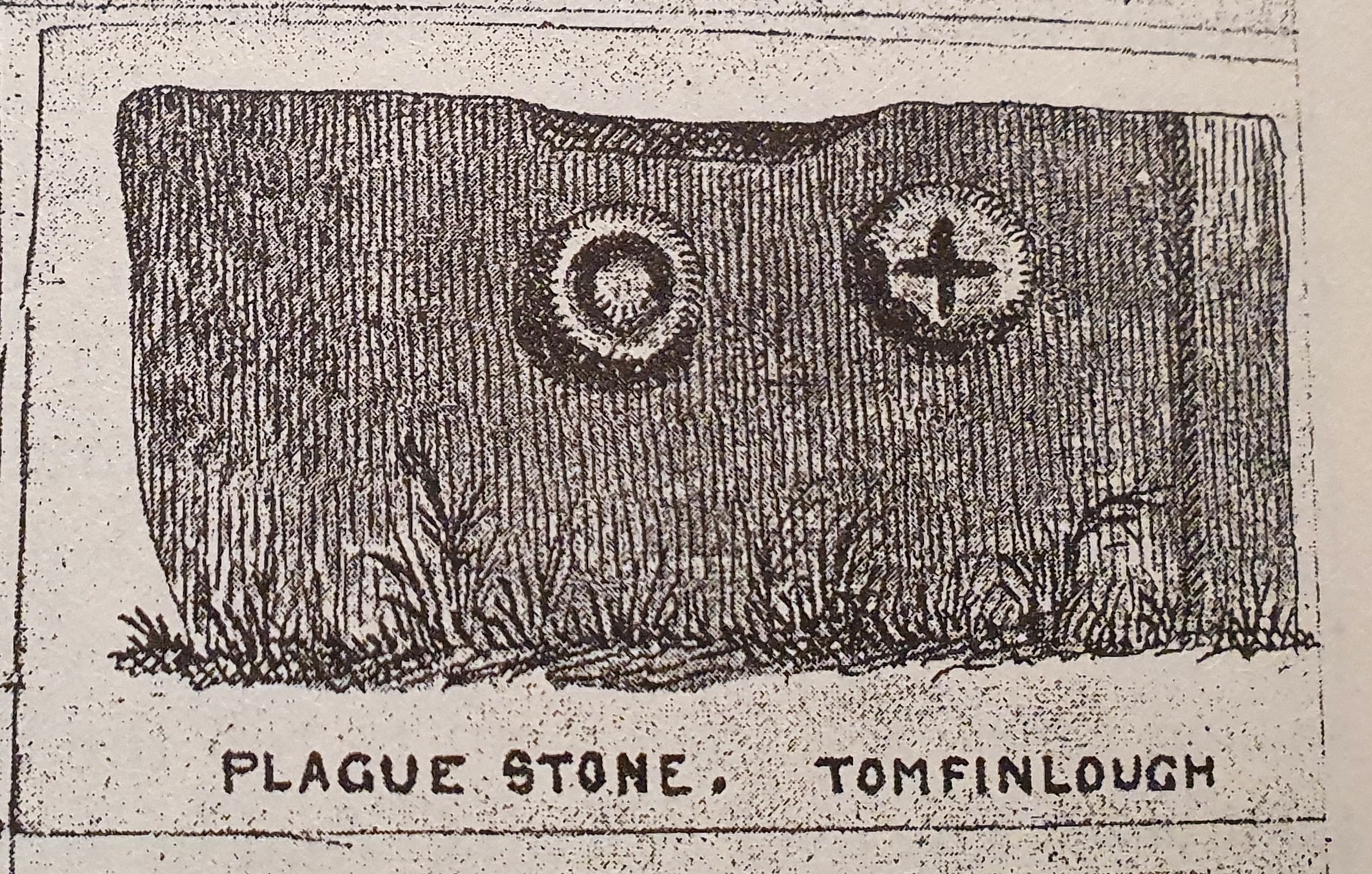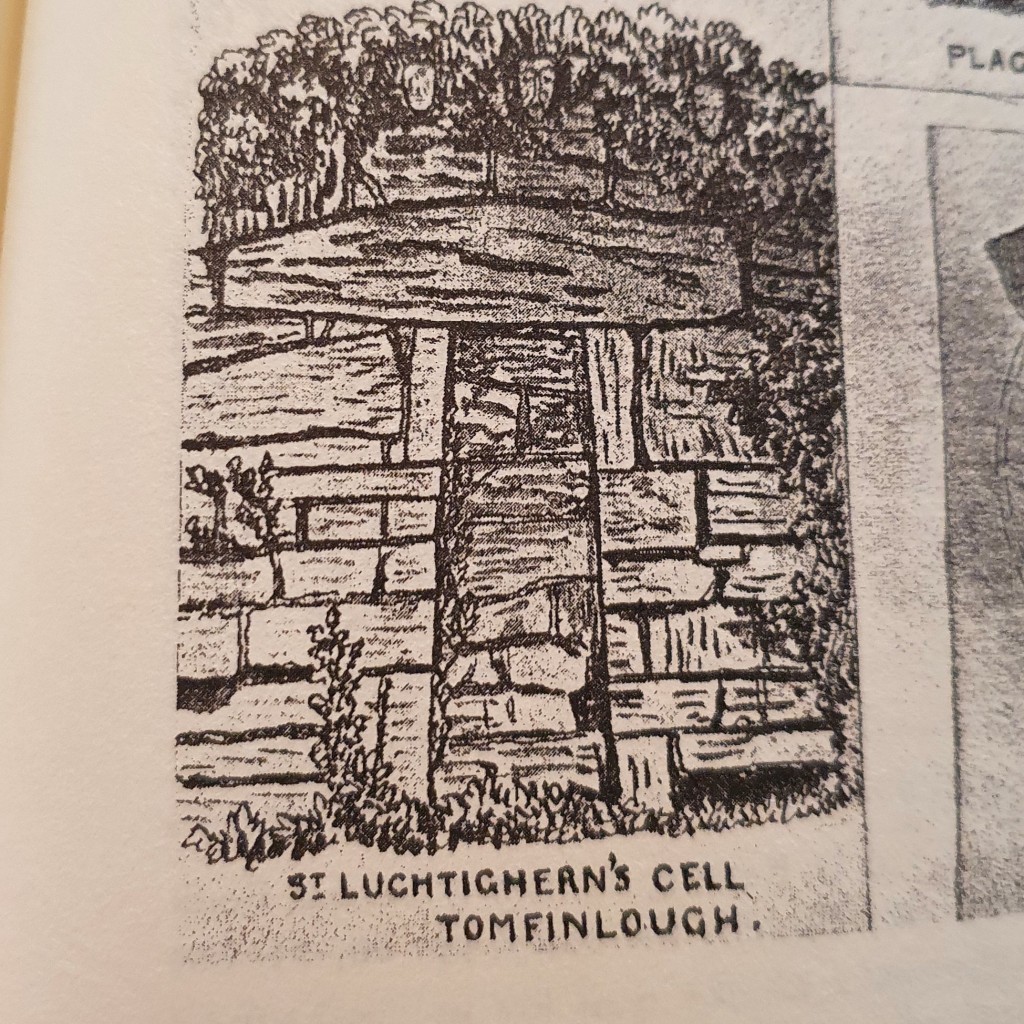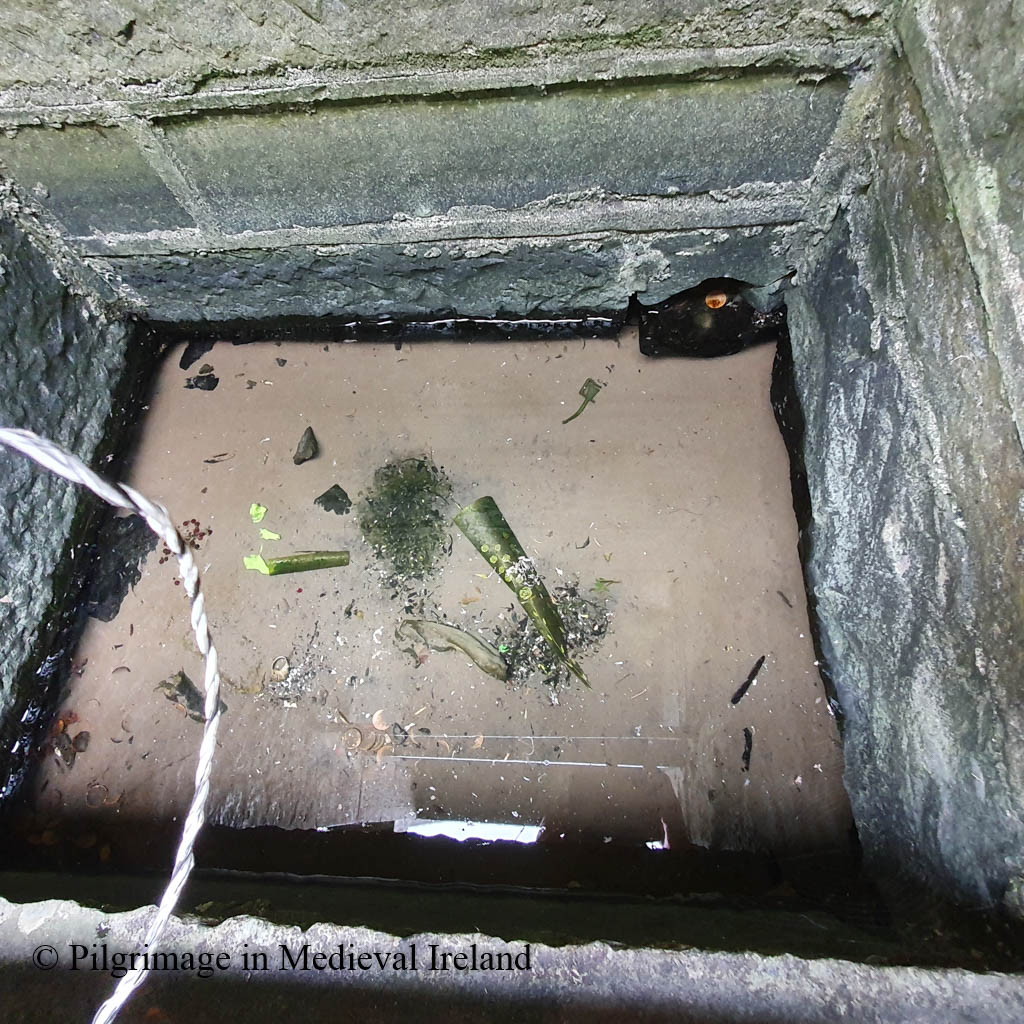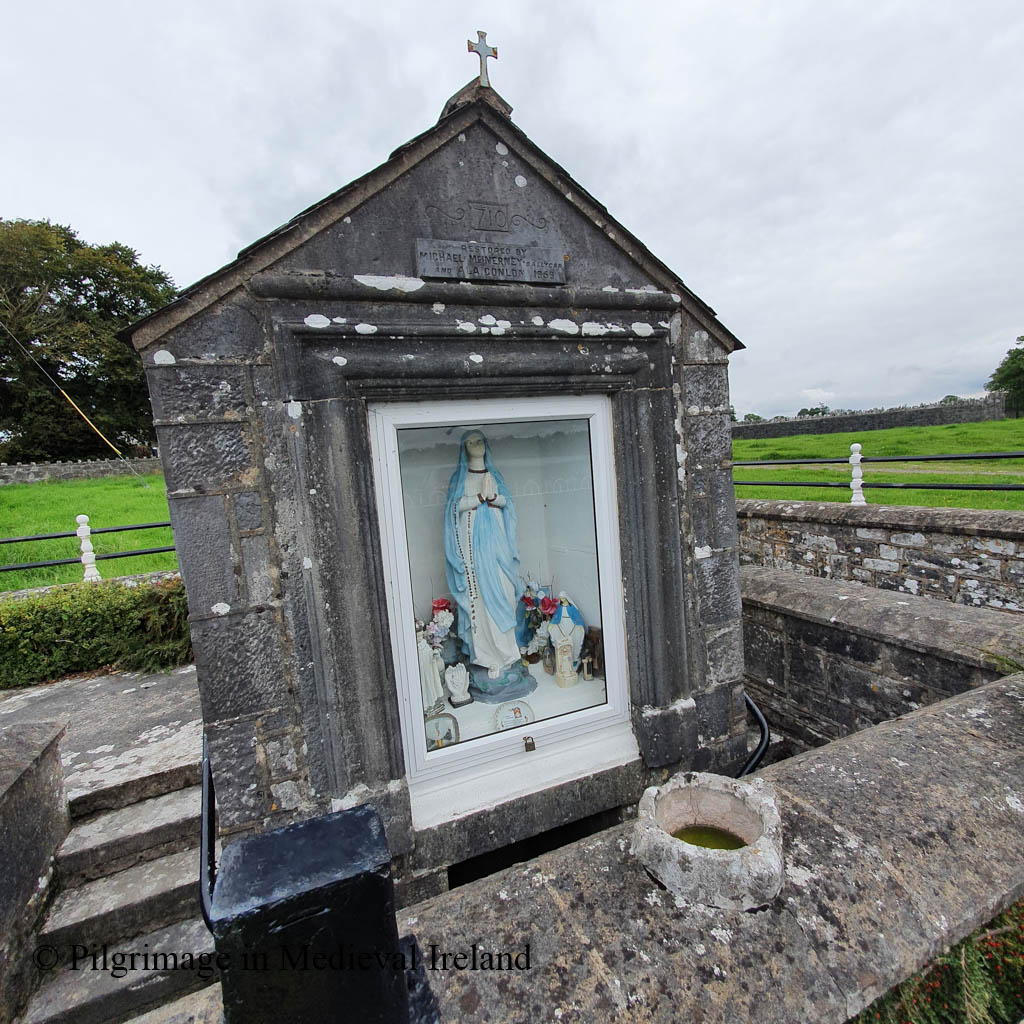Many years ago I came across an intriguing antiquarian account of a miraculous stone from Co Clare, known as the Tomfinlough Plague Stone.

The plague stone is located at the ruins of Fenloe/Tomfinlough church (townland of Finlough/Tuaim Fhionnlocha) and historic graveyard in east Co Clare, n a scenic location overlooking Fenloe lake. Folklore records the lake was once home to a mermaid.
Long ago the mermaid used to be seen in Fenloe Lake and she combing her hair with a golden comb. In summer time. All the people used to see her.
The Schools’ Collection, Volume 0599, Page 244
Fenloe church is located at the site of an early medieval monastery which was founded in the sixth century by St. Luchtighern. The Dictionary of Irish Saints tells us the saint belonged to the Tradraighe tribe, whose lands ‘were almost co-extensive with the barony of Bunratty’. The saint’s feast was traditionally commemorated on the 28th April.
Eugene Curry who visited Fenloe in 1839, noted there was no patron saint within the parish but Luchtighern’s memory seems to have been revived at a later date and by the 1930s the saint was mentioned by name in the schools essay.
Little is known of the history of the early medieval monastery, except for a handful of entries that are to be found in the Irish annals from the late tenth and eleventh century. For example, the Annals of the Four Masters recorded the death of the abbot of Fenloe monastery in A.D 944:
Scannlan, Abbot of Tuaim-Finnlocha …died
Annals of the Four Masters (https://celt.ucc.ie/published/T100005B/index.html)
Decades later in A.D 1048, the Annals of the Four Masters, recorded the death of another member of the religious community.
Tuathal Ua Muirgheasac, lector of Tuaim-Finnlocha, died.
Annals of the Four Masters https://celt.ucc.ie/published/T100005B/index.html
The church was also attacked by Turlough O’Brien the King of Munster, in the company of the men of Connaught, in A.D 1054.
Toirdhealbhach O’Briain, accompanied by the Connaughtmen, went into Thomond, where he committed great depredations, and slew Aedh, son of Ceinneidigh, and plundered Tuaim-Finnlocha.
Annals of the Four Masters https://celt.ucc.ie/published/T100005B/index.html
By the twelfth century Tomfinlough had become a parish church. Apart from some masonry in the present church, no trace of the early monastery can be seen above ground today.
The current church is a multi-period building with
evidence of building and refurbishment over three separate phases. Large blocks of masonry around the door area represent the earliest phase, and may date to between the tenth and the twelfth century. During the Anglo-Norman occupation of this area in the late thirteenth and early fourteenth centuries, the church was restored and some fine cut sandstone windows were inserted into the south wall and east gable….Finally, in the fifteenth century, the triple light east window was blocked up and a double light trefoil-pointed limestone window was inserted. The doorway was also inserted in the fifteenth century. A buttress has been erected against the southeast corner to support the leaning east gable.
Rian na Manach p 49
Today the church is in poor conditions. The walls are covered in thick ivy that obscures much of the surviving windows and other features. The north wall of the church fell in 1907 and the east gable was blown down by strong winds in January 2007.






The church is surrounded by a rectangular graveyard. The north and west walls are quite tall and were formerly boundaries to gardens connected with nearby Fenloe house. Curry, when he visited here in 1839 noted the remains of a second church built into the garden wall.

About sixty yards south from the east angle of the Church and included in a kitchen garden wall, is a pieces of a wall nine feet high and twelve feet three inches long, finished at the extremities with large cut stones, like the angles of the gable of a house, and having a quadrangular doorway in the centre measuring four feet ten in height from the present level of the ground, one foot nine and a half inches in breadth at top and two feet two inches at bottom, covered by a lintel stone five feet long and ten inches thick, but what the condition or appearance of this piece of wall may be on the other side I was not able to ascertain as it forms part of the wall of a gentleman’s kitchen garden, to which I could not at the time gain access.
O’Donovan & Curry p 201
Curry recorded and illustrated three carved head sitting over the lintel in the door described in the wall.
Over the doorway are placed three heads (human), sculptured in stone…
O’Donovan & Curry p 201
Westropp in 1910-13 provides a second account and drawing of the door and heads.


During my visit I didn’t see any further indications of the ancient building. The medieval heads described by Curry are still present but no longer sit over the lintel door, suggesting the wall must have been rebuilt since Westropp’s visit.
Stone Heads
The three carved heads are be found in the south-east corner of the graveyard, built in a line into the upper course of the wall. All three heads are medieval in date. The central head is the best preserved and is carved from limestone; two weathered sandstone heads sit on either side of it.

The Plague Stone
A carved stone as the ‘plague stone’ is located on the exterior of the west wall of the graveyard and is accessed by a stile in the wall. The stile incorporates a coffin rest. Clare historian Michael Houlihan defines these interesting features as follows
These rests are sections of the cemetery wall that are slightly lower than the parapet, with a reasonably wide and level section about a metre in length, fashioned to allow a coffin to rest without disturbance. These remaining rests usually have one or two stiles or stepping stones on either side to allow the bearers to enter with the coffin.
https://heritage.clareheritage.org/places/reading-your-local-landscape/kilkishen-our-local-landscape/coffin-resting-stones-in-clare
The plague stone is a little difficult to find. When you climb over the stile, head south towards the holy well and the road, and you will see the stone set in the lower course of the graveyard wall. It comprises a large block of stone that is slightly lighter in colour then the rest of the wall. Two circular projections are to be found at the top of the stone: the southern-most example was depicted in the early 1900’s as having a simple Latin cross carved in its centre (Westropp 2003, 93).

Folklore connected with Fenloe tells of a mysterious plague which was ravaging the country. The abbot of Fenloe cured the first local person who contracted the disease and banished the plague into a large stone, which became known thereafter as the plague stone. Variations of this tale are found in the schools collection and there was a reference to people visiting the stone to obtain healing. The oldest known account of it is to be found in the Ordnance Survey Letters of 1839 outlined below
Long ago a great plague raged all over Ireland and the people were dying in thousands from it every day. It made its appearance in large lumps or boils on the head and no medieval or surgical skill was found to prevail against it. It first broke out in the north of Ireland and soon extended its ravages to the other parts of the Island. When the old Priests of Toomfenlough had heard of its near approach to that part of the Country, he called his flock together, exhorted them to make their souls and requested that the first person in his Parish who should be afflicted with the disease would come to him without a moment’s delay.
In a day or two afterwards as he with two other ecclesiastics of his establishment were making lay in the little meadow near the Church, he had caught the plague and begging of him to come near her. He ran forward the plague then was; she pointed at once to two large lumps and dashed them against the stone, upon which one of them broke and its contents escaped, while the other one remained unbroken. (The broken on is represented on the stone by the figure of the inverted saucer, and the unbroken one by the other figure). The woman was cured immediately of her distemper and after returning many thanks and prayers to the good old Priest set off about her business
O’Donovan & Curry , p203.
The schools essay from Ballycar, Co. Clare note that the stone was visited by people suffering from swollen joints, who would rub the effected limb against the stone making the sign of the Cross.
There are two round prints on the stone. When the people go to visit Fenloe well on the 28th of April, they go to this stone and rub their legs against it three times, blessing themselves at the same time. There was a stone near the well in Fenloe called the Cholera stone and if any person had a sore leg and rubbed it to the stone the person would be cured.
The Schools’ Collection, Volume 0598, Page 463
The school essays for Newmarket records similar healing properties for the stone.
There is a large partly oval stone forming the corner stone of the boundary wall of Fenloe Burial ground Newmarket-on-Fergus Co Clare. There are marks on the stone – one is a misshapen cross, and the shape of a large circle can be traced on the margin of the stone. People that do the pilgrimage to The Blessed Well of St Lutigern quite convenient, never neglect visiting the stone, and rub their legs to the stone making the Sign of the Cross with them whilst doing so. It is said that when St Lutigern lived, the cholera was very brief in Newmarket and surrounding districts. People came to the Saint to be cured. There were so many people afflicted by the disease, and St Lutigern was so occupied ministering to them, that he blessed this large stone and ordered all people afflicted with the cholera to rub their legs to the stone, making the sign of the Cross on it with them, whilst doing so. People possessed of the proper Faith were always effectually cured. At the present day people affected with swollen joints believe that by rubbing them to the stone and making the sign of the Cross with the injured joint that the swelling will disappear. Some people attach a symbolic meaning to the markings on the stone. They say that the circle indicates eternity and that the Cross signifies Salvation.
The Schools’ Collection, Volume 0599, Page 213
The schools essays for Stonehall Co Clare tell a different story.
Here also is a ‘plague-stone’. Sufferers from the Cholera touched this stone and were cured. One day a cholera victim was digging his grave in the churchyard. A stranger came in and questioned him. The man told the stranger he was digging his own grave as he expected to die from the disease. The stranger pounced upon him and removed two pieces of his flesh which he threw against a stone in the wall. He then told the man to touch the stone. He did so and was cured.
The Schools’ Collection, Volume 0599, Page 316-317
Folklore relating to the three medieval stone heads
The medieval heads mentioned above also have a rich folklore connected to them.
Near the south-east corner of the graveyard there are three stone heads on the boundary wall and their story is connected with that of the plague stone. The story goes that there were three on lookers at the incident of the miraculous cure and one of them was very sceptical. The abbot had three heads carved and mounted over the church door. He placed the head representing the unbeliever in the middle, saying it would gradually yield to the elements while the other two heads would forever remain unaffected by weather
https://www.clarelibrary.ie/eolas/coclare/places/nof_history.htm
Another story from the schools essays from Ballycar
There is a story told about the images of three priests which are to be seen on the boundary wall opposite to that of the cholera stone. The three images are side by side. he centre image represents a martyr of the faith. The image on the right is a repentant martyr and the other one is a traitor which is effaced.
The Schools’ Collection, Volume 0599, Page 294-295




Fenloe holy well
Another interesting feature at the site is a holy well at the roadside near the edge of the graveyard. The well sits within a small rectangular area enclosed by a low stone wall and it is covered by well-house which incorporate statue niche and gravestone. A series of steps lead down to a water-filled rectangular recess.




The well house was restored and rebuilt in 1959 by Michael McInerney and Ala Conlon.



A medieval stone mortar, which has been incorrectly described as a bullaun stone, sits on the wall above the well. recess. Mortars were used with a pestle for grinding food and herbs for cooking or medicines. A similar mortar dated to the 13th century is part of Museum of London catalogue.



Rounds were performed at the well in the 1930s on St Luchtigern’s feast day and offerings left at the well to this day show it is still visited by pilgrims.
pilgrimage is made on April 28th. Five decades of the Rosary are recited. Pictures, medals, crucifixes are left at the shrine, and rags and pieces of cord [?] are attached to a bush nearby. The Schools’ Collection, Volume 0599, Page 316
The waters from St Luchtigern’s well was said to have curative power and was especially favoured for a cure for sore eyes (The Schools’ Collection, Volume 0598, Page 463)
The school essays Newmarket on Fergus, Co. Clare, provide insight into devotional rituals in at the well in the 1930s
They say the Rosary there. They also drink some of the water and rub it to the diseased part. They bring some of it home but they do not use it for ordinary household purposes.
The Schools’ Collection, Volume 0598, Page 464
Reference
Harbison , P. Rian na Manach. A guided tour of the ecclesiastical treasures in Co Clare. https://www.clarecoco.ie/services/planning/publications/heritageconservation/rian-na-manach-clare-ecclesiastical-trail-2006-8938.pdf
Houlihan, M. 2015. The holy wells of County Clare. Walsh Colour Print, Castleisland, Ireland.
O’Donavan, J & Curry, E. 2003(reprint). The Antiquities of County Clare. Ennis: (Clare Local Studies Project ) Clasp Press.
Westropp, T. J. 2003(reprint). Folklore of Clare. Ennis: (Clare Local Studies Project) Clasp Press
The Schools’ Collection, https://www.duchas.ie/en/cbes
Archival Reference The school of Newmarket.The Photographic Collection, F025.19.00225
https://www.clarelibrary.ie/eolas/coclare/places/nof_history.htm
http://newmarketonferguscommunityhall.ie/articles/fenloe.html
http://newmarketonferguscommunityhall.ie/articles/fenloe.html
https://www.logainm.ie/en/6506
https://collections.museumoflondon.org.uk/online/object/35614.html
https://www.clarelibrary.ie/eolas/coclare/archaeology/ryan/part3_chapter32_tomfinlough.htm


